Health clinic at Buddhist monastery the subject of new documentary
Health clinic at Buddhist monastery the subject of new documentary |
- Health clinic at Buddhist monastery the subject of new documentary
- Art, drama and poetry meet on Karmapa`s creative canvas
- 5 Spiritual Practices for Aging Well
- Tenzin Palmo to share her views at Florida Atlantic University
- Myanmar to build Buddhist shrine in Chinese temple
- Pad Yatra: Buddhists Draw Attention Towards Environment
- China tries to make the Buddha smile
- The Real Buddha Bar, Tended By Tokyo Monks
- Happy New Year
| Health clinic at Buddhist monastery the subject of new documentary Posted: 30 Dec 2011 09:00 AM PST Tristan Stoch, a 21-year-old Port Townsend filmmaker, is currently on location in Nepal, working on his latest project. The film, tentatively titled Compassion Connects: Acupuncture and Primary Care in Nepal, will focus on a health clinic adjacent to a Buddhist monastery that is run by the Acupuncture Relief Project (ARP). Stoch plans to finance his latest documentary with funds raised through his KickStart campaign, which to date has raised just over $ 6,000 (about half of his ultimate goal). Stoch wishes "to show the potential ARP's model has for primary care in the Third World, to expose caregivers from the health care community to the work that ARP is doing in Nepal, and to attract future volunteers and expand ARP's work to the rest of the Third World." Stoch says that "pledged money will help cover his medical, insurance and equipment expenses in Nepal and allow him to edit the expected 100 hours of footage into a 20- to 30-minute film." To help finance this project, visit his KickStart campaign page. See also Tristan's Facebook page and Tumblr blog, as well: http://tristanstoch.tumblr.com/ Read More @ Source |
| Art, drama and poetry meet on Karmapa`s creative canvas Posted: 29 Dec 2011 10:00 PM PST IANS, December 29, 2011New Delhi, India -- When Ogyen Trinley Dorje is not busy managing his 900-year-old religious order, the 17th Karmapa likes to do more human and colourful things - painting and writing poetry, songs and plays.
"Art for me is a way of resting and replenishing my mind. As the person who holds the name of Karmapa, I hold so many responsibilities that need to be completed, to be accomplished, but not everything goes according to plan. It can be exhausting sometimes. What I like about painting a picture is that when I sit down to paint, I complete it," the Karmapa told reporters here. The `sense of completion that goes along with completing the picture and the artistic ability` inspire him, the Karmapa said. "Even when I am drawing, there is something about the process of painting that brings peace and relaxation to my mind," the Karmapa said. A series of six of his art works released as a New Year memento shows his mastery over his craft. The most striking among the art works made public is a roaring tiger ready to spring. Painted in water colour and ink, the exquisite Chinese style painting drawn to meticulous realistic details, depicts the snarling tiger poised on the trunk of an old tree - with its fangs bared. A pen and ink drawing of the seated Buddhist goddess Tara on a lotus - the harbinger of good luck and wealth - is an example of the artist`s felicity with lines and free-hand strokes. The drawing stands out for its flowing details and intricacy.
"Basically, I started making (painting) pictures when I was quite young. I have always enjoyed doing it. In case of drama, it happened some time later during my days as the Karmapa (out of necessity). But I engaged in poetry naturally from a young age (along with art)," the Karmapa said. Many of the songs written by the Karmapa have been set to music by the Tibetan Institute of Performing Arts (TIPA) - a 54-year-old Dharamshala-based Tibetan performing arts and culture promotion and conservation platform. One of his plays, `Life of Milarepa`, an operatic Tibetan theatre combined with elements of modern drama in six acts, drew more 20,000 people when it was staged in Bodh Gaya by TIPA in January 2010. Scripted, produced and overseen by the Karmapa, the relay (long) play narrates the story of the life of the Buddhist monk Milarepa, a Tibetan Buddhist master and a hero for his battles with evil. The play, often described as one of the longest and the most opulent Tibetan stage productions - has been compiled into a DVD. A voracious reader, the Karmapa reads in the only language he is proficient in - Tibetan. "I read all kinds of Tibetan compositions which include fiction, poetry and all kinds of literary art works," the Karmapa said. He watches "some Hollywood and some Asian movies". "I like movies which have deeper meanings to them - not just about entertainment and dramatic action. If it is a movie about war, it has to be about the journey of the mind about the process of war and the depth of human experience. It has to provide some valuable angle. In terms of plays and other forms of art, there are so many that it is The Karmapa`s message for youth - both in India and across the world - is that "there has been a lot of material advancement, a lot of advancement related to the external world, but this advancement has the net effect of limiting our own personal freedom". "So in the light of the situation, it is very important to build our inner world of our mind as well. Buddhism offers methods to do that," the Karmapa said. Read More @ SourceBuddhism vs Islam 3/3 This posting includes an audio/video/photo media file: Download Now |
| 5 Spiritual Practices for Aging Well Posted: 29 Dec 2011 09:00 PM PST by Lewis Richmond, The Huffington Post, Dec 29, 2011
Lewis Richmond, author of "Aging as a Spiritual Practice: A Contemplative Guide to Growing Older and Wiser" gives five key tips on being happy in our golden years San Francisco, CA (USA) -- I often teach that Buddhism is about how to be truly happy, so I have been studying the new research field of "happiness studies," which focuses on the objective measures and causes of happiness.
Gratitude. When I ask audiences what they like about being older, people often answer "Gratitude," and then say what they are grateful for: grandchildren, good health, free time, wearing what they want, the chance to travel, giving back to the community. One person included the ham sandwich she had just had for lunch. I have an exercise I call the "thank you" prayer. People repeat the words "thank you" silently to themselves and watch what comes up. It's amazing how many and how readily images of gratitude come to mind. Generosity. One happiness study reported that if giving weren't free, drug companies could market a great new drug called "give back" instead of Prozac. It's scientifically proven: giving back and helping others makes us feel happier and more content. Giving is a universal spiritual value taught by every religion, and the desire to give back naturally increases as we age.
Reframing. Aging includes its share of reverses, losses and sorrows. What makes the difference is our attitude about them. If a bad knee means we can't jog anymore, we needn't despair; we can take up swimming. If we lost money in the recession, we can cherish what we still have. If we become ill, we rejoice when we recover. I have developed a meditation called "Vertical Time" that focuses on the positive aspects of the present, rather than regrets of the past and worries about the future. We tend to think of time as linear and horizontal, but it is also vertical -- one breath at a time. Vertical Time is really breath-based reframing. Curiosity. Curiosity is an important attitude to cultivate as we age. There's a tendency to hunker down in our old familiar routines. It's good to resist that temptation. Physical exercise grows new muscle, mental activity grows new brain cells, emotional engagement lifts the spirit. Curiosity keeps us young; we need to cherish it. If you see an interesting ad for a wildlife class, consider taking it. If you go into a bookstore, try browsing in sections you don't usually visit. If you haven't seen a friend in too many years, reach out. Children are naturally curious, and we can be too. Flexibility. Things change as we age, and some of those changes are irrevocable. Our youthful stamina is gone forever; a dying friend will never return. In the face of these changes, it's important that we not become rigid and stuck in our ways. With every reversal comes new opportunity. No matter what the issue, no matter how big the problem, there is always something constructive that you can do. Never give up, never let aging get the better of you. This is how the "extraordinary elderly" do it -- the ones who have beaten the odds to enjoy their old age to the very end. The Spiritual Life. A spiritual perspective on aging is not just for personal transformation; it is a medicine for longevity and health. Research shows that people with an active involvement in church or spiritual community live on average seven years longer than those who don't. These five practices for aging well really work; science says so, common sense says so, and every religion says so. Aging As A Spiritual Practice builds on these truths to treat the process of aging as an opportunity for inner transformation. We deserve to enjoy our aging; it is our reward in the continuing adventure of living a whole and fulsome life. ---------- Aging as a Spiritual Practice: A Contemplative Guide to Growing Older and Wiser Thai Students Compete in English Quiz This posting includes an audio/video/photo media file: Download Now |
| Tenzin Palmo to share her views at Florida Atlantic University Posted: 29 Dec 2011 08:00 PM PST by Marci Shatzman, The Sun Sentinel, December 28, 2011Florida, USA -- When Buddhist nun Jetsunma Tenzin Palmo speaks about her new book, "Into the Heart of Life," at Florida Atlantic University's Peaceful Mind/Peaceful World outreach series on Jan. 7, it will be her first visit to Florida.
That rare visit to the United States is why Boca Raton philanthropist Barbara Schmidt wanted to bring Palmo here to share her world view with the public. "I had been reading her for years; she's an amazing human being and I love the way the writes," said Schmidt, whose Schmidt Family Foundation partners with FAU for the peace program. She will introduce Palmo. When she learned Palmo would be speaking at a retreat at the well-known Omega Institute for Holistic Studies in the Hudson Valley, N.Y., Schmidt went there to hear her. "She spoke to me; she's very humorous and light hearted," Schmidt said by phone. "Leading a life of purpose is not meant to be hard. It's glorious and light. This is a beautiful way to live and I don't have to live in a cave for 12 years." Palmo is actually famous for that. Raised in London, she became a Buddhist at age 20. In India she met her guru and became one of the first Westerners to be ordained as a Tibetan Buddhist nun. When she went to the Himalayas to study, she ultimately lived in a cave for 12 years. "Cave in the Snow" was written about that experience, but it's a reference she would like to move beyond. "Most people are most curious about my time in the cave but that ended in 1988," she said. "Now my concern is running a nunnery."
Educating Buddhist nuns all over the world has become her main cause. "We want to equalize the gender imbalance in Buddhist and all the world religions by logic and reasoning," she said. "We want to educate the nuns and give them the practical experience so they can assume leadership.'' There's no shortage of women who want to become Buddhist nuns; they have no viable economic alternatives. "In their part of Asia, their only opportunity is to get married and have endless children and do farm work," she said. But their status and educational opportunities vary widely. "Nuns have a full ordination in China, and in Tibet they have novice ordination and that's what we're working for now, the full ordination for nuns in Buddhist countries," which the Buddha gave them, she said. "As with Catholic nuns, there's a lot of male opposition. Slowly, slowly, it takes time to rethink their attitude." Palmo will be in Boca Raton after she attends an interfaith gathering in the Bahamas that was started by a Hindu group, she said. Tickets for her talk are $ 15 and students are admitted free. Tickets can be purchased at fauevents.com or by calling 800-564-9539 . The Peaceful Mind/Peaceful World Series is presented by FAU's Peace Studies Program in the Dorothy F. Schmidt College of Arts and Letters. Read More @ Source |
| Myanmar to build Buddhist shrine in Chinese temple Posted: 29 Dec 2011 07:00 PM PST Xinhua, Dec 29, 2011 ZHENGZHOU, China -- Baima Temple, the oldest Buddhist temple in China, will see a new exotic shrine, funded by the Myanma government, rise in its courtyard next year, local religious affairs authorities said.
Construction on the shrine, which will be designed, funded and built by the government of Myanmar, will begin in April next year, said an official with the religious affairs bureau in Luoyang, capital city of central Henan province, where the temple is located. The 1,943-year-old Baima Temple, or White Horse Temple, is the first Buddhist temple in China and is considered "the cradle of Chinese Buddhism" by most believers. The 35-million-yuan project (about 5.56 million U.S. dollars), which will include a shrine, a pagoda and a museum, will cover an area of 7,000 square meters, and construction is expected to take about 18 months, the official said. In order to make the shrine in a genuine Myanma style, most of the materials and decorations will be shipped from Myanmar. The Myanmar Buddha hall will not be the temple's first exotic shrine, as it is already home to an Indian shrine and a Thai shrine. Read More @ SourceMindful way Part 3 This posting includes an audio/video/photo media file: Download Now |
| Pad Yatra: Buddhists Draw Attention Towards Environment Posted: 29 Dec 2011 06:00 PM PST The Buddhist Channel, Dec 30, 2011DELHI, India -- A strong contingent of 600 Monks and Nuns led by His Holiness the Gyalwang Drukpa (spiritual head of the Drukpa Lineage) are on a Pad Yatra (walking pilgrimage) from Mumbai to Sanchi via Ajanta Ellora spreading the message of peace, harmony, goodwill and respect for the environment.
His Holiness is the recipient of United Nation's Millennium Development Goal (MDG) award for his efforts towards the environment. Earlier, in 2010, his Holiness had led a drive to safeguard the Himalayas by ensuring plantation of a million trees in the Ladakh region, a feat that was recognised by the Guinness World Records. The total distance covered by these environmental crusaders is over 1500 kilometres out of which around 750 kilometres would be on foot. Thousands of people, including 450 monks and nuns, followers and supporters are taking part in the Pad Yatra, along with various national and international celebrities and Drukpa followers.
This is the 5th Pad Yatra that His Holiness is undertaking. Since 2006, His Holiness has taken students on foot journeys through Bihar, Uttar Pradesh, Ladakh, Manali, Sikkim and Darjeeling, each time the Yatris picked up more than one ton of non-biodegradable waste and educated populace in the remote areas about the importance of keeping environment clean and green for future generations. The Pad Yatra which aims to bridge spirituality and materialism through promoting a life in harmony with nature, will cover other notable destinations like Kanheri Caves, Elephanta Caves, Kondana Caves, Karjat, Rajmarchi, Karla Bhaja, and Aurangabad. This uncommon Pad Yatra is a brainchild of His Holiness the Gyalwang Drukpa. Visiting power places of great blessings, promoting awareness on environmental issues as well as encouraging spiritual development within oneself through familiarizing with the breathe of nature are the things that His Holiness always does, on foot. Talking about this quest and spiritual adventure His Holiness the Gyalwang Drukpa said, "This Pad Yatra symbolises the journey from self to selflessness. On the personal side, this is an effort to come closer to nature and enjoy its bounty by way of an encounter of the close kind. On another front, this is an effort to raise awareness about the environment, and ensuring that there is widespread education on the various facets that focus on environment and sustainability subjects." About His Holiness the Gyalwang Drukpa The India-born Buddhist spiritual guru, His Holiness the Gyalwang Drukpa is an active proponent of Peace and Harmony through putting compassion and love into action. He is most lauded for promoting gender equality and awareness in environmental issues. He is the United Nations Millennium Development Goals (MDG) Award recipient and Green Hero of India. His Kung Fu nuns were featured on the Life Series broadcasted by BBC World News in September 2011. He also led Ladakh in breaking the Guinness World Records for "Most Trees Planted" category on 10th October 2010. He is also the founder of the school in Ladakh which featured in the popular movie "The 3 Idiots" and is now more popularly known as Rancho's school. -------- The photographs of the Pad Yatra are uploaded here: http://www.mediafire.com/?3i45ugopgs3ad To Follow His Holiness in action during the Pad Yatra on facebook and for more photographs of the Pad Yatra, go to: http://www.facebook.com/#!/Drukpa.Order Read More @ SourceAjahn Sona UBC Asian Centre Retreat morning talk This posting includes an audio/video/photo media file: Download Now |
| China tries to make the Buddha smile Posted: 29 Dec 2011 05:00 PM PST by Jayadeva Ranade, DNA India, December 27, 2011New Delhi, India -- Foreign Affairs establishments of major nations usually include, among their practitioners of 'realpolitik', a select band of Sinologists, Kremlinologists and the like. China's foreign affairs establishment appears to have a group of professionals specialising in kasaya (garments worn by Buddhist monks and nuns) politics, or 'kasayapolitik'! These experts are mainly in the Chinese Communist Party (CCP)'s United Front Work Department (UFWD) and China's Ministry of Foreign Affairs.
Since the CCP indicated approval of Buddhist slightly over five years ago, describing it as an "ancient Chinese religion", the Chinese authorities have sought to use it to achieve strategic and domestic objectives. They convened World Buddhist Forums to appeal to the Buddhists in China as well as portray to neighbouring, predominantly Buddhist, countries that China's communist regime is tolerant of Buddhist. It is also projected China's 'soft power'. Vice President Xi Jinping, then Party Secretary of Zhejiang province and now tipped to take over as China's President in 2012, helped organise the first World Buddhist Forum in 2006. A large number of foreign monks, nuns and scholars were invited to this Forum, where Beijing projected the China-appointed Panchen Lama, Gyancain Norbu.
Amid these initiatives, China accelerated preparations for the post-Dalai Lama phase. In 2007, it promulgated regulations that only Beijing can approve 'living Buddhas' and high lamas, including the Dalai Lama and Panchen Lama. It increased interaction with Tibetan Buddhist 'traditions', high-ranking lamas and others critical of the Dalai Lama. Beijing simultaneously began wooing the Karma Kagyu 'tradition' of Tibetan Buddhist, which exercises considerable influence in large areas of Tibet and the mountainous Indo-Himalayan border belt. Large numbers of Buddhists in Ladakh follow this 'tradition' as do the majority of those resident in Sikkim and Bhutan. The Karma Kagyu is presently riven with dissension with four claimants to the position of XVIIth Gyalwa Karmapa. Ughyen Thinley Dorje, recognised as the XVIIth Gyalwa Karmapa by the Dalai Lama and Beijing, escaped from Tsurphu monastery near Lhasa into India in 2000. While suspicions about the manner of his escape linger, a Hong Kong source recently claimed that the day after his escape Beijing's State Council sought confirmation from an interlocutor as to whether Ughyen Thinley Dorje had escaped to India. In this backdrop, the visit to Hongkong in February by Thaye Thinley Dorje, a major rival to the position of XVIIth Gyalwa Karmapa, and the Hongkong Buddhist Association's convention in October to felicitate the Karma Kagyu 'tradition', assume significance. Neither could have been organised in Hong Kong without Beijing's approval. The UFWD is obviously wooing Thaye Thinley Dorje Meanwhile, after a three-day conclave with senior Tibetan Buddhist leaders in Dharamsala mainly to discuss his reincarnation, the Dalai Lama criticised Chinese authorities for manipulating Tibetan religious beliefs and practices for political ends. He described the regulations promulgated in 2007, as "outrageous and disgraceful". Asserting that "they are waiting for my death", he cautioned Tibetans to "bear in mind that, apart from the reincarnation recognised through such legitimate methods, no recognition or acceptance should be given to a candidate chosen for political ends by anyone, including those in the People's Republic of China". He also exhibited his spiritual authority, pre-empted the Chinese, and accorded official recognition to 'Jonang' as the new, fifth 'tradition' of Tibetan Buddhist. In the interregnum, tension has risen in Tibetan areas in China with twelve reported instances of self-immolation by ordained monks and nuns. Contact between Beijing and the Dalai Lama's envoys, however, remain suspended. As China prepares for the Party Congress in October 2012, prospects for any change in the policy on Tibet appears remote. The entire incumbent top leadership last year approved the long term policies adopted for Tibet. Zhang Qingli, the Tibet Party Secretary till August 2011, credited with saying "the Dalai Lama is a wolf in monk's robes, a devil with a human face but the heart of a beast", is also likely to be promoted to the powerful Politburo. His experience of managing the restive Xinjiang-Uyghur and Tibet Autonomous Regions will ensure him a say in policies relating to China's minorities. ---------- Ven Drubwang Konchok Norbu Rinpoche : Om Ma Ni Pad Me Hung . This posting includes an audio/video/photo media file: Download Now |
| The Real Buddha Bar, Tended By Tokyo Monks Posted: 29 Dec 2011 04:00 PM PST by Lucy Craft, NPR, December 29, 2011
At Vow's Bar in Tokyo, Buddhist monks run the place and serve up advice along with cocktails. Here's a monk serving drinks on Monday. Tokyo, Japan -- Another Friday night at this tiny neighborhood watering hole in Tokyo: By 7:30, the bar stools and tables in this cozy joint are filling up; office workers settle in with their cocktails and Kirin beers. And by a little after 8, it's time for the main act.
A pair of younger monks — conspicuous with their shaved heads, bare feet and religious garb — man the bar. For a non-Buddhist American like me, they shake up an order of the house specialty, shakunetsu jigoku, or "Burning Hell," and boy, they're not kidding. This city is said to be honeycombed with 10,000 nightspots, most no bigger than an American living room. So to Japanese, it makes perfect sense that Buddhist monks would run their own themed bars, complete with incense, mandala sacred posters and religious altars. As for the monks themselves, they say that tending bar is, ironically, one of the best ways of connecting with their roots.
Getting Out Of The Temple Trying to suss out just what their job is about has prompted a younger generation of Japanese monks to undertake all sorts of endeavors. They start rock bands, open coffee shops and rent out their temples to theatrical productions and concerts as they search for ways of making themselves as central to their communities as their forefathers were back in the 15th century. To these men of the cloth, in other words, it's high time get out of the temple and go to where their flocks are. Among tonight's flock is an office worker who said she spent an hour getting here, to seek counsel from the monks. She doesn't offer details, but the monks say they are asked about everything from wayward boyfriends to office politics. "I tell people not everything is preordained or destiny," one of the younger monks says. "Love and affection change. So sometimes there's no point to trying to hang onto a relationship." But the transition from austere temple to honky-tonk is not easy, the head monk confesses. "At the temple, folks are always well-behaved and attentive, no matter how long or boring the sermon is," Taguchi says. "Here at the bar, they don't like my sermons — they walk out." But for customers looking to get their advice straight up and their spirits lifted, the Buddhist bar is one place where there's always a sympathetic ear - all night long. Read More @ SourceWhat is Buddhism? This posting includes an audio/video/photo media file: Download Now |
| Posted: 29 Dec 2011 01:00 PM PST With best wishes from Sumeru… Sentiments we share with the card's creators at the Ontario Consultants on Religious Tolerance. Read More @ Source |
| You are subscribed to email updates from BuddhaRocks ☸ Buddhist To stop receiving these emails, you may unsubscribe now. | Email delivery powered by Google |
| Google Inc., 20 West Kinzie, Chicago IL USA 60610 | |


 An accomplished artist, the Karmapa sketches and paints with water colour.
An accomplished artist, the Karmapa sketches and paints with water colour.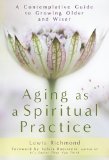 Researchers have found three factors that reliably increase happiness as we grow older -- gratitude, generosity and reframing (seeing your situation from a more positive perspective). Not surprisingly, the Buddhist tradition offers these same three factors as spiritual practices for cultivating happiness. I would add two more -- curiosity and flexibility.
Researchers have found three factors that reliably increase happiness as we grow older -- gratitude, generosity and reframing (seeing your situation from a more positive perspective). Not surprisingly, the Buddhist tradition offers these same three factors as spiritual practices for cultivating happiness. I would add two more -- curiosity and flexibility.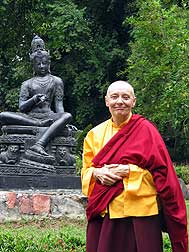 "I was in the U.S. last June, and I'm there every one or two years," Palmo said in a phone interview.
"I was in the U.S. last June, and I'm there every one or two years," Palmo said in a phone interview..jpg) << Baima is famed among Chinese people as the country's first Buddhist temple
<< Baima is famed among Chinese people as the country's first Buddhist temple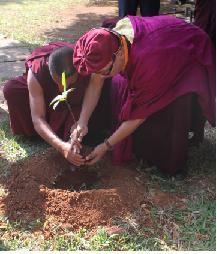 The Pad Yatra was formally flagged off from Mumbai, India's corporate capital on 10th December. This Pad Yatra will pass through Ajanta Ellora (a UNESCO world heritage site) between 24th to 29th December, and ends in Bhopal on 6th January 2012. The walk will finally conclude formally in Delhi on 8th January with a public discourse by His Holiness the Gyalwang Drukpa wherein he will again reinforce his message of respect for nature and the environment.
The Pad Yatra was formally flagged off from Mumbai, India's corporate capital on 10th December. This Pad Yatra will pass through Ajanta Ellora (a UNESCO world heritage site) between 24th to 29th December, and ends in Bhopal on 6th January 2012. The walk will finally conclude formally in Delhi on 8th January with a public discourse by His Holiness the Gyalwang Drukpa wherein he will again reinforce his message of respect for nature and the environment. 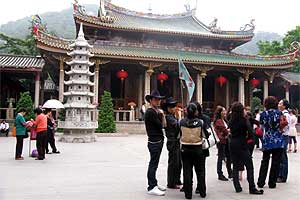 << Chinese government support for Buddhist is increasing
<< Chinese government support for Buddhist is increasing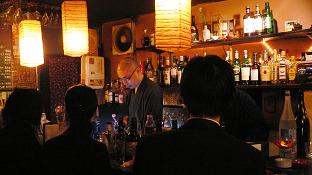 Vow's Bar in the Yotsuya neighborhood has no house band, no widescreen TV, no jukebox. But it does have a chanting Buddhist monk so tipplers can get a side of sutras with their Singapore Slings or something even more exotic.
Vow's Bar in the Yotsuya neighborhood has no house band, no widescreen TV, no jukebox. But it does have a chanting Buddhist monk so tipplers can get a side of sutras with their Singapore Slings or something even more exotic.